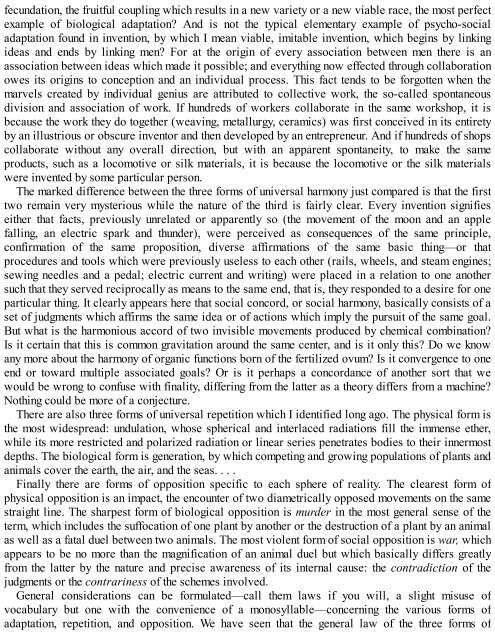3658925934
You also want an ePaper? Increase the reach of your titles
YUMPU automatically turns print PDFs into web optimized ePapers that Google loves.
fecundation, the fruitful coupling which results in a new variety or a new viable race, the most perfect<br />
example of biological adaptation? And is not the typical elementary example of psycho-social<br />
adaptation found in invention, by which I mean viable, imitable invention, which begins by linking<br />
ideas and ends by linking men? For at the origin of every association between men there is an<br />
association between ideas which made it possible; and everything now effected through collaboration<br />
owes its origins to conception and an individual process. This fact tends to be forgotten when the<br />
marvels created by individual genius are attributed to collective work, the so-called spontaneous<br />
division and association of work. If hundreds of workers collaborate in the same workshop, it is<br />
because the work they do together (weaving, metallurgy, ceramics) was first conceived in its entirety<br />
by an illustrious or obscure inventor and then developed by an entrepreneur. And if hundreds of shops<br />
collaborate without any overall direction, but with an apparent spontaneity, to make the same<br />
products, such as a locomotive or silk materials, it is because the locomotive or the silk materials<br />
were invented by some particular person.<br />
The marked difference between the three forms of universal harmony just compared is that the first<br />
two remain very mysterious while the nature of the third is fairly clear. Every invention signifies<br />
either that facts, previously unrelated or apparently so (the movement of the moon and an apple<br />
falling, an electric spark and thunder), were perceived as consequences of the same principle,<br />
confirmation of the same proposition, diverse affirmations of the same basic thing—or that<br />
procedures and tools which were previously useless to each other (rails, wheels, and steam engines;<br />
sewing needles and a pedal; electric current and writing) were placed in a relation to one another<br />
such that they served reciprocally as means to the same end, that is, they responded to a desire for one<br />
particular thing. It clearly appears here that social concord, or social harmony, basically consists of a<br />
set of judgments which affirms the same idea or of actions which imply the pursuit of the same goal.<br />
But what is the harmonious accord of two invisible movements produced by chemical combination?<br />
Is it certain that this is common gravitation around the same center, and is it only this? Do we know<br />
any more about the harmony of organic functions born of the fertilized ovum? Is it convergence to one<br />
end or toward multiple associated goals? Or is it perhaps a concordance of another sort that we<br />
would be wrong to confuse with finality, differing from the latter as a theory differs from a machine?<br />
Nothing could be more of a conjecture.<br />
There are also three forms of universal repetition which I identified long ago. The physical form is<br />
the most widespread: undulation, whose spherical and interlaced radiations fill the immense ether,<br />
while its more restricted and polarized radiation or linear series penetrates bodies to their innermost<br />
depths. The biological form is generation, by which competing and growing populations of plants and<br />
animals cover the earth, the air, and the seas. . . .<br />
Finally there are forms of opposition specific to each sphere of reality. The clearest form of<br />
physical opposition is an impact, the encounter of two diametrically opposed movements on the same<br />
straight line. The sharpest form of biological opposition is murder in the most general sense of the<br />
term, which includes the suffocation of one plant by another or the destruction of a plant by an animal<br />
as well as a fatal duel between two animals. The most violent form of social opposition is war, which<br />
appears to be no more than the magnification of an animal duel but which basically differs greatly<br />
from the latter by the nature and precise awareness of its internal cause: the contradiction of the<br />
judgments or the contrariness of the schemes involved.<br />
General considerations can be formulated—call them laws if you will, a slight misuse of<br />
vocabulary but one with the convenience of a monosyllable—concerning the various forms of<br />
adaptation, repetition, and opposition. We have seen that the general law of the three forms of









![Genki - An Integrated Course in Elementary Japanese II [Second Edition] (2011), WITH PDF BOOKMARKS!](https://img.yumpu.com/58322134/1/180x260/genki-an-integrated-course-in-elementary-japanese-ii-second-edition-2011-with-pdf-bookmarks.jpg?quality=85)
![Genki - An Integrated Course in Elementary Japanese I [Second Edition] (2011), WITH PDF BOOKMARKS!](https://img.yumpu.com/58322120/1/182x260/genki-an-integrated-course-in-elementary-japanese-i-second-edition-2011-with-pdf-bookmarks.jpg?quality=85)





